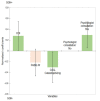Persistent Spinal Pain Syndrome Type 2 (PSPS-T2), a Social Pain? Advocacy for a Social Gradient of Health Approach to Chronic Pain
- PMID: 34202362
- PMCID: PMC8269084
- DOI: 10.3390/jcm10132817
Persistent Spinal Pain Syndrome Type 2 (PSPS-T2), a Social Pain? Advocacy for a Social Gradient of Health Approach to Chronic Pain
Abstract
The Social Gradient of Health (SGH), or position in the social hierarchy, is one of the major determinants of health. It influences the development and evolution of many chronic diseases. Chronic pain dramatically affects individual and social condition. Its medico-economic impact is significant and worldwide. Failed Back Surgery Syndrome or Persistent Spinal Pain Syndrome type 2 (PSPS-T2) represents one of its most fascinating and disabling conditions. However, the influence of SGH on PSPS-T2 has been poorly explored. We designed a prospective multicentric study (PREDIBACK study) to assess the SGH prevalence, and to examine its association with medical and psychological variables, in PSPS-T2 patients. This study included 200 patients to determine the SGH association with pain (NPRS), Quality of life (EQ-5D-5L), kinesiophobia (FABQ-Work), catastrophism (CSQ), and functional capacity (ODI). Around 85.3% of PSPS-T2 patients in our study had low SGH. Low SGH patients had a higher FABQ-Work and CSQ-Catastrophizing score than high SGH patients (p < 0.05). High SGH patients have a higher ODI score than low SGH patients (p < 0.10). Our results suggest that SGH is a relevant factor to guide prevention, research, and ultimately intervention in PSPS-T2 patients and could be more widely transposed to chronic pain.
Keywords: failed back surgery syndrome; persistent spinal pain syndrome type 2; social determinants of health; social gradient of health.
Conflict of interest statement
Nicolas Naïditch reports non-financial support and speaker fees from Medtronic, outside the submitted work. Philippe Page reports non-financial support from Medtronic, outside the submitted work. Élodie Charrier reports non-financial support and personal fees from Medtronic and Grunenthal, outside the submitted work. Simon Teyssedou reports personal fees from Medtronic, Safe Orthopaedics and Spineart, outside the submitted work. Maarten Moens reports speaker fees from Medtronic and Nevro, outside the submitted work. Tanguy Vendeuvre reports grants from Medtronic, Johnson et Johnson and Safe Orthopaedics. He reports personal fees grom Spineart, Medtronic and Safeorthopaedics, outside the submitted work. Philippe Rigoard reports grants and personal fees from Medtronic, Abbott and Boston Scientific, outside the submitted work. Maxime Billot, Philippe Cornet, David Le Breton, Manuel Roulaud, Amine Ounajim, Bertille Lorgeoux, Kévin Nivole, Pierre Pries, Cécile Swennen, Géraldine De Montgazon, Pierre Descoins, Brigitte Roy-Moreau, Nelly Grimaud, Lisa Goudman, Romain David, have nothing to disclose.
Figures


References
-
- Inoue S., Kamiya M., Nishihara M., Arai Y.-C.P., Ikemoto T., Ushida T. Prevalence, Characteristics, and Burden of Failed Back Surgery Syndrome: The Influence of Various Residual Symptoms on Patient Satisfaction and Quality of Life as Assessed by a Nationwide Internet Survey in Japan. J. Pain Res. 2017;10:811–823. doi: 10.2147/JPR.S129295. - DOI - PMC - PubMed
-
- Corbin J., Strauss A. Managing Chronic Illness at Home: Three Lines of Work. Qual. Sociol. 1985;8:224–247. doi: 10.1007/BF00989485. - DOI
-
- Blond S., Mertens P., David R., Roulaud M., Rigoard P. From “Mechanical” to “Neuropathic” Back Pain Concept in FBSS Patients. A Systematic Review Based on Factors Leading to the Chronification of Pain (Part C) Neurochirurgie. 2015;61(Suppl. S1):S45–S56. doi: 10.1016/j.neuchi.2014.11.001. - DOI - PubMed
Grants and funding
LinkOut - more resources
Full Text Sources

